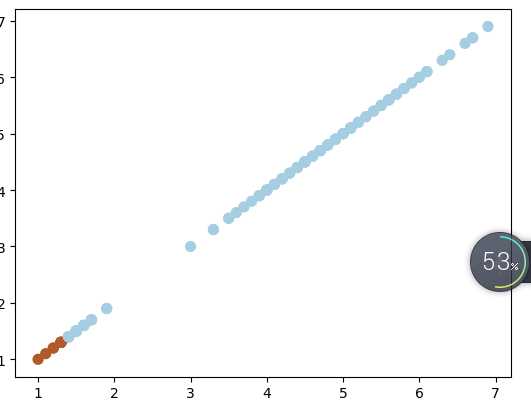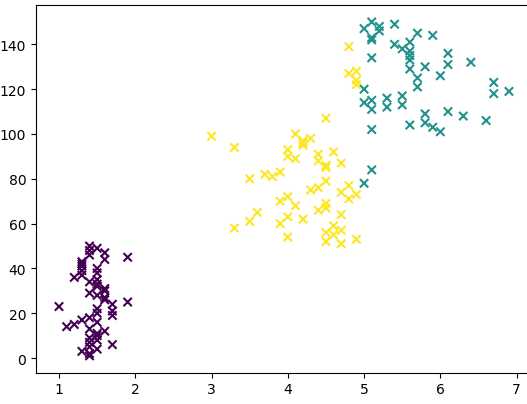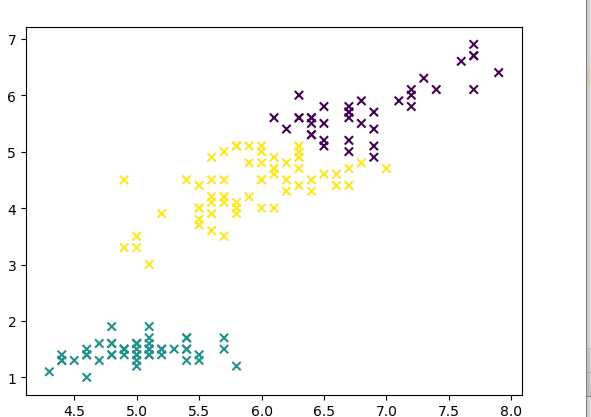10.25
Posted zhangjij
tags:
篇首语:本文由小常识网(cha138.com)小编为大家整理,主要介绍了10.25相关的知识,希望对你有一定的参考价值。
importnumpy as np
x = np.random.randint(1,50,[20,1])y = np.zeros(20)k = 3def initcenter(x,k): return x[:k]kc = initcenter(x,k)kcdef nearest(kc,i): d=(abs(kc-i)) w=np.where(d==np.min(d)) return w[0][0]kc = initcenter(x,k)nearest(kc,93)def xclassify(x,y,kc): for i in range(x.shape[0]): y[i] = nearest(kc,x[i]) return ykc = initcenter(x,k)y = xclassify(x,y,kc)print(kc,y)def kcmean(x,y,kc,k): l = list(kc) flag = False for c in range(k): m = np.where(y == c) n = np.mean(x[m]) if l[c] != n: l[c] = n flag = True print(l,flag) return (np.array(l),flag)kc = initcenter(x,k)flag = Truek = 3while flag: y = xclassify(x,y,kc) kc,flag = kcmean(x,y,kc,k) 
2鸢尾花花瓣长度数据做聚类并用散点图显示
#鸢尾花花瓣长度数据做聚类并用散点图显示。
import numpy as np
from sklearn.datasets import load_iris
iris = load_iris()
x = iris.data[:,2]
y = np.zeros(150)
def initcenter(x,k): #初始聚类中心数组
return x[:k]
def nearest(kc,i): #数组中的值,与聚类中心最小距离所在类别的索引号
d = (abs(kc-i))
w = np.where(d == np.min(d))
return w[0][0]
def xclassify(x,y,kc):
for i in range(x.shape[0]): #对数组的每个值进行分类,shape[0]读取矩阵第一维度的长度
y[i] = nearest(kc,x[i])
return y
def kcmean(x,y,kc,k): #计算各聚类新均值
l = list(kc)
flag = False
for c in range(k):
print(c)
m = np.where(y == c)
if len(m) == 1:
n = x[c]
else:
n=np.mean(x[m])
if l[c] != n:
l[c] = n
flag = True #聚类中心发生变化
print(l,flag)
return (np.array(l),flag)
k = 3
kc = initcenter(x,k)
flag = True
print(x,y,kc,flag)
#判断聚类中心和目标函数的值是否发生改变,若不变,则输出结果,若改变,则返回2
while flag:
y = xclassify(x,y,kc)
kc, flag = kcmean(x,y,kc,k)
print(y,kc,type(kc))
print(x,y)
import matplotlib.pyplot as plt
plt.scatter(x,x,c=y,s=50,cmap="Paired");
plt.show()


3.用sklearn.cluster.KMeans,鸢尾花花瓣长度数据做聚类并用散点图显示.
from sklearn.cluster import KMeans import numpy as np from sklearn.datasets import load_iris import matplotlib.pyplot as plt data = load_iris() iris = data.data petal_len = iris[:,2:3] print(petal_len) k_means = KMeans(n_clusters=3) #三个聚类中心 result = k_means.fit(petal_len) #Kmeans自动分类 kc = result.cluster_centers_ #自动分类后的聚类中心 y_means = k_means.predict(petal_len) #预测Y值 plt.scatter(petal_len,np.linspace(1,150,150),c=y_means,marker=‘x‘) plt.show()

4.鸢尾花完整数据做聚类并用散点图显示.
from sklearn.cluster import KMeans import numpy as np from sklearn.datasets import load_iris import matplotlib.pyplot as plt data = load_iris() iris = data.data petal_len = iris print(petal_len) k_means = KMeans(n_clusters=3) #三个聚类中心 result = k_means.fit(petal_len) #Kmeans自动分类 kc = result.cluster_centers_ #自动分类后的聚类中心 y_means = k_means.predict(petal_len) #预测Y值 plt.scatter(petal_len[:,0],petal_len[:,2],c=y_means,marker=‘x‘) plt.show()

以上是关于10.25的主要内容,如果未能解决你的问题,请参考以下文章